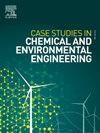从废物到资源:国王椰子生物炭作为一种绿色吸附剂去除双酚a
Q1 Environmental Science
Case Studies in Chemical and Environmental Engineering
Pub Date : 2025-07-23
DOI:10.1016/j.cscee.2025.101261
引用次数: 0
摘要
双酚a在水体中的广泛存在引起了重大的环境和健康问题,突出表明需要可持续和有效的去除技术。本研究提出了一种利用从椰子壳中提取的生物炭来修复双酚a的创新方法。椰子壳是一种很容易获得的农业废料,也是亚洲许多地区流行饮料的副产品。生物炭在800℃热解时去除率最高,经HCl活化后去除率达到80.1±0.9%。进一步将粒径从1.0-4.0 mm减小到75-105 μm,可以完全(100%)去除BPA。批处理吸附实验结果表明,在pH为3 ~ 7、投加量为5.0 g/L、初始BPA浓度为1000.0 ppm的条件下,BPA的去除率最佳。Langmuir等温吸附模型(R2 = 0.99)描述了该吸附过程,最大吸附量为39.53 mg/g。动力学研究表明,伪二阶模型准确地反映了吸附动力学,表明化学吸附是限速步骤。利用乙醇再生实验证明了吸附剂的可重复使用性,在连续5次循环后,吸附剂的去除率保持在79.6%以上。这些发现强调了KBC800-HCl作为一种可持续的高性能吸附剂的有效性,表明了农业废弃物在环境修复中的更广泛潜力。本文章由计算机程序翻译,如有差异,请以英文原文为准。

From waste to resource: King coconut biochar as a green adsorbent for bisphenol A removal
The widespread presence of BPA in water bodies poses significant environmental and health concerns, highlighting the need for sustainable and efficient removal technologies. This study presents an innovative approach for BPA remediation using biochar derived from king coconut shells—a readily available agricultural waste and by-product of a popular drink in many parts of Asia. Biochar pyrolyzed at 800 °C exhibited the highest removal efficiency, which was significantly enhanced to 80.1 ± 0.9 % following HCl activation. Further reduction of the particle size from 1.0–4.0 mm to 75–105 μm resulted in complete (100 %) removal of BPA. Batch adsorption experiments revealed optimal removal at pH 3–7, with a dosage of 5.0 g/L and an initial BPA concentration of 100.0 ppm. The adsorption process was best described by the Langmuir isotherm model (R2 = 0.99), with a maximum capacity of 39.53 mg/g. Kinetic studies demonstrated that the pseudo-second-order model accurately represented the adsorption dynamics, implying chemisorption as the rate-limiting step. Regeneration experiments using ethanol demonstrated the reusability of the adsorbent, maintaining over 79.6 % removal efficiency after five consecutive cycles. These findings highlight the effectiveness of KBC800–HCl as a sustainable and high-performance adsorbent, demonstrating the broader potential of agricultural waste valorization in environmental remediation.
求助全文
通过发布文献求助,成功后即可免费获取论文全文。
去求助
来源期刊

Case Studies in Chemical and Environmental Engineering
Engineering-Engineering (miscellaneous)
CiteScore
9.20
自引率
0.00%
发文量
103
审稿时长
40 days
 求助内容:
求助内容: 应助结果提醒方式:
应助结果提醒方式:


